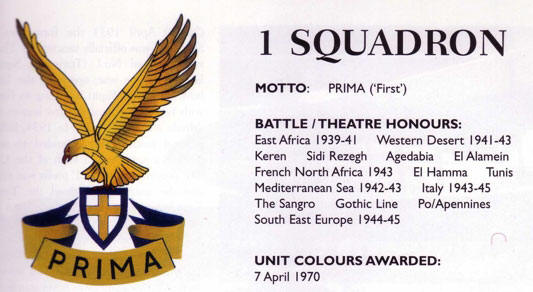Squadrons of the
South African Air Force
and their aircraft
1920-2005

by
Steven McLean
illustrated by Darry
Legge
S u m m a
r y
|
|
ISBN: |
0
9584929 4 8 |
|
Media: |
464
pages, hardback
cover |
|
Price: |
ZAR 450 |
|
Review
Type: |
First
Read |
|
Advantages: |
Good
coverage of history and operations of all SAAF Squadrons,
especially of WW2, Korea and Border War actions; over 800
photos. Colour illustrations of all Squadron emblems.
|
|
Disadvantages: |
No
aircraft profiles. |
|
Recommendation: |
Recommended |
Reviewed by Sinuhe Hahn

HyperScale
is proudly supported by Squadron.com
Following his successful
treatise of the Spitfire in SAAF service, author Steven McLean has taken
on an even more daunting task, namely a detailed history of all 62 SAAF
full strength squadrons, reserve and commando squadrons, as well as the
10 training units, in 85 years of SAAF existence. This has obviously
been no easy task, as conflicting opinions of what to include or exclude
could readily result in a dull treatise of dates, names and locations. I
am happy to say that Steven has managed this mammoth undertaking with
bravura, and even though I have already spent many hours perusing this
hefty tome of 464 pages, I have not yet felt the need to use it as a
cure for insomnia. Indeed, I am constantly discovering new little
titbits of information.
Examples of such a small
personal highlight is the report that early markings used by 1 Squadron
while stationed in North Africa were painted in light duck egg blue, and
not white, as is so frequently assumed: the colour was just so pale that
it appears white on certain black and white (orthrochromatic)
films. Another titbit is a peculiarity of 1 Squadron that I (and many
other fellow SAAF hobby historians) was not aware of was the use of
personal nose art decorations, such as the leaping Springbok used by Lt.
Stewart “Bomb” Finney on his Hurricane MKIIC. “Bomb”, incidentally wrote
the preface for this book.

Such items are littered
throughout this book, which goes to great detail to mix a faithful
record of dates and places (the SAAF moved around a lot in WW2, from
Abyssinia to Italy and Austria/Germany via North Africa) the various
squadrons were stationed during their lengthy combat careers, with
personal anecdotes.
For 2 Squadron “The Flying
Cheetahs”, this covers exploits in WW2 with P-40’s and
Sptfires, Korea with F-51’s and F-86’s, the
drawn out “Border War” in Angola using Mirage IIIC and E’s, to the
equipping with Atlas Cheetahs in the late 1980’s and current
preparations for receipt of the new SAAB Gripen.
The history of 3 Squadron
devotes considerable space in recording the exploits of the SAAF
greatest ace, Jack Frost, in considerable detail, including his daring
rescue by Lt. R.H. Kershaw in a Hawker Hurricane following the crash
landing of the former. The most famous South Africans, such as “Sailor
Malan” and “Pat Pattle”,
flew for the RAF. Of particular interest in this section on 3 Squadron
is the report concerning the capture, repair and unfortunate flight (and
crash) of an Italian Fiat Cr 42 complete in SAAF markings, using photos
I had not seen before. Modern history of this squadron recalls its
resurrection when equipped with Mirage IIIEZ fighters in the 1960’s, the
subsequent acquisition of the Mirage F1CZ interceptors and the only two
post WW2 Mig-21 kills by a SAAF unit (1 Mig-15 kill in Korea was never
fully credited).
Another item of personal
interest to me, which is not widely reported, was the description
of of 4 Fighter
Bomber Squadron activities in the Border War, where they used their
Atlas Impala MkII’s (Aermacchi
MB 326K) to great effect by shooting down a half-dozen Mil-Mi 18 and
Mil-Mi 25 Hind helicopters.
The mix of WW2 and modern
combat history makes for particularly interesting reading, as the reader
gets a glimpse into how the structure and function of many squadrons
changed completely over time. While several squadrons traded their fixed
wing aircraft for rotors, the example of 10 Fighter Bomber Squadron is
probably the most extreme as currently this unit, which flew Spitfires
in WW2, is totally devoted to the use of unmanned aerials vehicles (UAV’s).
History is history, war is
hell no matter which side one is on, and it is refreshing to see that
many of the unpleasant events are not simply glossed over. These need
not only relate to loss of personnel in battle (such as the loss of
numerous B-34 aircraft during attempts to supply Polish fighters in
Warsaw), but also tragedies which occur by a series of errors, such as
the loss in the desert of a flight of three
Blenheims by 15 Bomber / Reconnaissance Squadron in the notorious
Kufra incident, where all crew members
perished in the desert following a navigation error.
This book also contains
numerous photos which will be of interest to many SAAF fans, ranging
from natural metal B-26 Marauders in WW2 to a modern day 4 Squadron
Impala MkI (Aermacchi
MB 326) resplendent in silver finish with bright day glow red/orange
markings. Colour illustrations of all squadron emblems are provided.
As such, I can heartily
recommend this book as a valuable resource to anybody interested in SAAF
history. The book is available directly from the author at
tangemere@mweb.co.za, or at
www.aviationshop.co.za. In Europe the book can be ordered from:
Luchtvaard Hobby Shop in
Amsterdam
www.lhshop.nl.
Note that only 600 copies have
been printed, which are selling out fast.
Review
Copyright © 2006 by Sinuhe Hahn
This Page Created on 05 February, 2006
Last updated 07 February, 2006
Back to HyperScale Main Page
Back to Reviews Page

Zerstörer Volume One is available online from Squadron.com
|
Home | What's
New | Features
| Gallery |
Reviews | Reference
| Forum
| Search